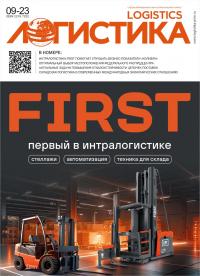Scientific & Practical Journal

Editorial News
Dear readers! We are pleased to present to you the eleventh issue of the journal in 2025. There are a lot of relevant and useful materials in the issue, which, hopefully, will not be ignored.
Dear readers! In September the CeMAT RUSSIA exhibition was held, which showed everyone that innovations and robotics are increasingly penetrating the logistics industry. We can safely say that many technologies are tested here, and only then they go out into the world. However, it is not only CeMAT RUSSIA that demonstrates the prevalence of the digital agenda.
Dear readers! This is the ninth issue of the journal, which turned out to be very rich and diverse. Traditionally, the issue is opened by an analyst. The material by Alina Nasyrova from the Market Guide Agency, dedicated to investments in warehouse complexes in Russia, recalls the importance of developing logistics infrastructure for the integrated development of regions.
PHOTO OF THE WEEK
CITATIONS
«Logistics» Journal № 9 / 2023
MARKET ANALYSIS
The vacancy rate in the warehouse real estate market of the regions of Russia has reached a record low
WAREHOUSE. INVENTORY MANAGEMENT
Optimal choice of location for the federal distribution Centre
The article provides a solution to the problem of finding the optimal location of a distribution center focused on processing FMCG flows from China. The search for a rational location for a distribution center was carried out using the method of minimizing transport and storage costs for various entry points of cargo flows into the territory of the Russian Federation through seaports and railway terminals.
SUPPLY CHAIN MANAGEMENT
Current challenges in increasing resiliency in supply chains
The article considers the conceptual foundations for ensuring the fault tolerance of supply chains. The fault tolerance property is manifested in the prevention, resistance and absorption of the effects of adverse external factors and the subsequent restoration of the supply chain performance. Supply chain resiliency management should consider ESG factors and sustainability goals. It is recommended that due diligence, traceability and transparency be used to identify and address irregularities in supply chains. The effectiveness of the implementation of these recommendations in large-scale supply chains can be significantly improved through the use of digital twins of supply chains
INFRASTRUCTURE
Overview of trends in the development of the charging infrastructure market for electric vehicles
The article provides an overview of indicators of the world market of electric vehicles, as well as the description of the motivating factors for the buyers of electric or hybrid vehicles. The development of public charging infrastructure is among the major factors influencing the consumption of electric vehicles. In the Russian Federation, the number of users of electric vehicles among private users is still relatively small and the market is still emerging. The article also describes several factors that influence the charging infrastructure location decisions.
The article proposes a methodology for the formation of a regional logistics infrastructure. Defined the object of study at the macro- and micro-level, the basic principles of the formation of logistics infrastructure, as well as the proposed stages of finding the optimal location of transport and storage infrastructure
PROBLEMS AND OPINIONS
Quantitative methods of analysis in modern tourism research
The article discusses statistical and economic and mathematical methods used in domestic and foreign scientific research of the tourism sector. Examples of the most popular approaches were identified. A list of basic tasks is given, for the solution of which quantitative methods of analysis were used. A logical block diagram of conducting research in the field of tourism using a modern mathematical apparatus is proposed. Problems have been highlighted that create difficulties in connecting the broad scientific community to analytical and prognostic work in tourism.
MANAGEMENT
Improving the operational efficiency of logistics business processes of an industrial enterprise based on process analytics
In the situation of the dominant position in the import-export communication of railway transportation, the primary role is assigned to the work with the life cycle of rolling stock when cars are on the company's sidings.
The process analytics algorithm described by the author of the article allows for express assessment of operations in the field of industrial logistics and the formation of economic justification of initiatives using infographics.
The subject of the article is the transformation of the role and importance of logistics in modern international economic relations with an emphasis on the functionality of warehousing in modern supply chains. The transformation of warehouse logistics goals in integrated supply chains, changes in their geographical directions, methods and specifics of work in modern conditions based on the use of the Internet and computer technologies, as well as various approaches in the methodology for evaluating their effectiveness are investigated. The trends affecting the strengthening of the role of logistics in the context of globalization are indicated. The reasons that led to an increase in the role of warehouses in the logistics chain are highlighted.












